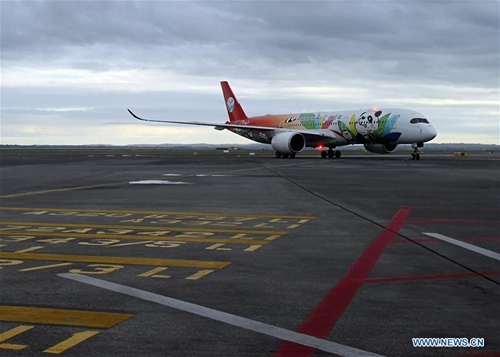HOME >> SOURCE
Chinese airlines post record monthly loss in February caused by virus: CAAC
Source:Global Times Published: 2020/3/12 18:03:43

An airbus A350 airliner of China's Sichuan Airlines painted with giant panda Photo: Xinhua
Chinese airliners saw a massive business slump in February because of the coronavirus assault, and international air transport faces serious challenges, the Chinese aviation regulator said on Thursday.
The industry recorded losses of 24.5 billion yuan ($3.51 billion) in February, including a loss of 20.96 billion yuan for the carriers, the largest on record, an official from the Civil Aviation Administration of China (CAAC) said.
"The COVID-19 outbreak has a major impact, and the aviation market has shrunk sharply," Zhang Qing, an official of the CAAC told a press conference, adding the loss in the first two months of the year hit 17.58 billion yuan.
Her words came amid the background of thousands of flights being cancelled in China due to the virus.
In February, China's aviation sector traffic saw a year-on-year decrease of 73.9 percent, with a total of 2.52 billion ton-km transported; passenger traffic stood at 8.34 million, a decrease of 84.5 percent; and cargo and mail transportation reached 297,000 tons, a decrease of 21 percent, the CAAC said.
To help the industry, the government has taken measures including direct cash incentives for global and domestic airlines that operate international flights into and out of China. It is believed that the government is paying to keep international routes open.
The CAAC also it supports airlines in flexibly adjusting flight plans, international route structures and slot quotas in accordance with market demand, as well as simplified route approval procedures, time coordination procedures, and shortened time limits for the approval (reinstatement) of international routes.
However, the dark days for the country's civil aviation industry could be gone quickly, with more flights having resumed and packages of government support.
From March 2 to 8, the domestic flight volume increased by 16 percent week-on-week, and returned to about 40 percent of the normal level, the CAAC said.
The flight numbers at the airports in Shenzhen, Chengdu and Chongqing returned to more than 60 percent of normal levels, it said.
"The network operated by the civil aviation market in China is basically normal," Liu Lusong, an official from the CAAC, said. Except for Hubei, the other regions' transport networks are unchanged, although the number of flights has decreased, he said.
As far as international aviation goes, although the number of passenger destinations has dropped by 34 flights, China still has connections, and freight transport network are basically the same as before, he explained.
Air China said in a note sent to the Global Times that from February 12 to 29, it has flew 18 round trips among Beijing, New York and Washington, with a transport volume of nearly 4,000 passengers.
Posted in: INDUSTRIES